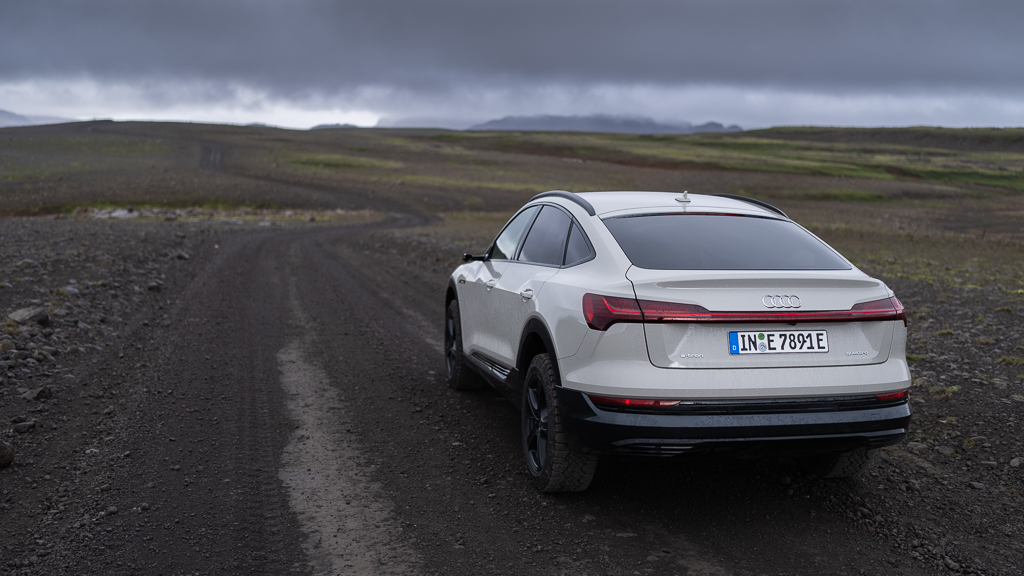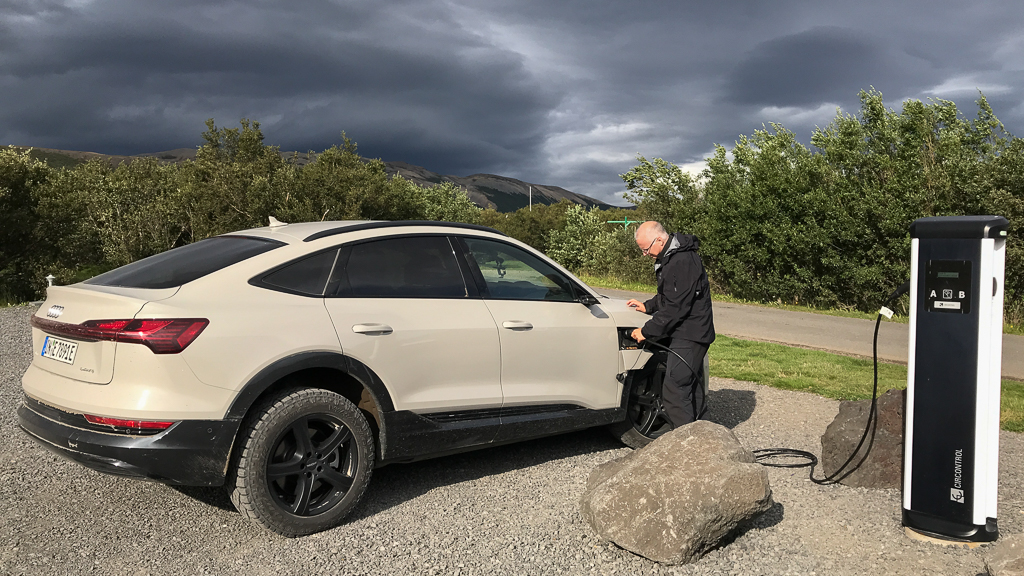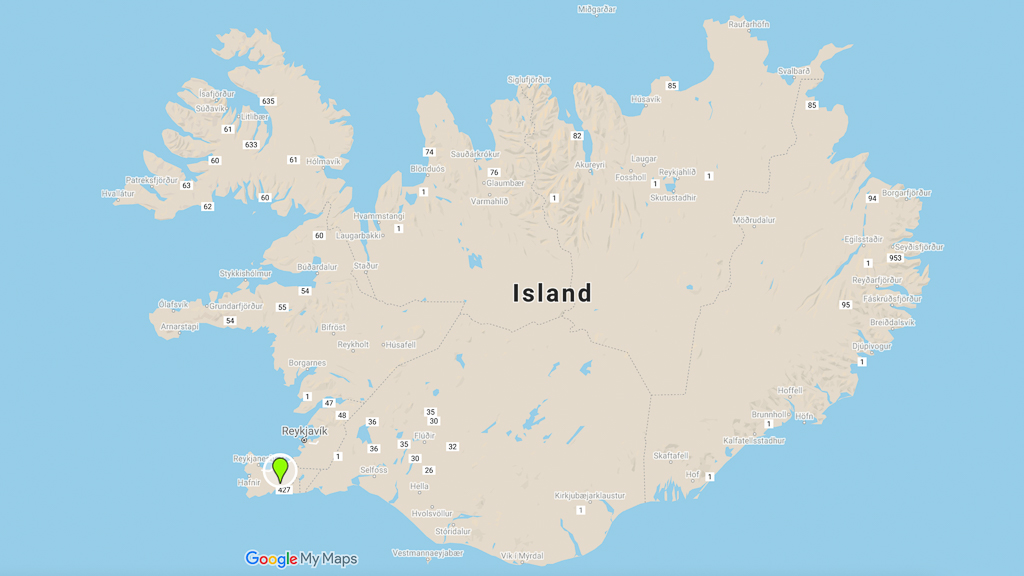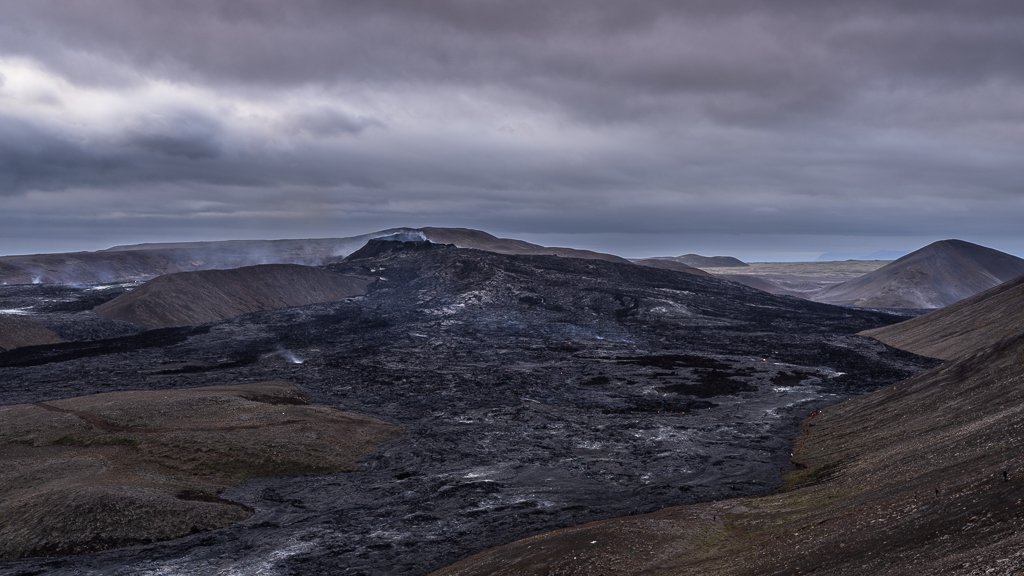This is part 4 of our road trip through the remote highlands of Iceland with the Audi e-tron. In case you missed it, you can find the start of our adventure here.
After crossing the Eastern Highlands along the Kjölur we arrived in Þingvellir. This is also the starting point for another famous highland track, the Kaldidalur (550) also known as Kaldadalsvegur.
Kaldidalur
This easy-to-drive gravel road leads from Þingvellir to Húsafell.


Before we enter the Kaldidalur we recharge the e-tron to 100% at a 50 kW DC charger at the Þingvellir tourist information.

There are no unbridged river crossings on the 550 and even a 2WD car with high ground clearance could easily manage it. But be careful if you have a rental car, often this track is only allowed for 4WD cars.
The Kaldidalur leads through a rugged landscape and is definitely worth a visit.




After 40 km we reached Húsafell, the end of the 550.
Húsafell
We spent the night at Hótel Húsafell. It is modern and clean but very expensive and definitely not worth the money. The staff was not very friendly (both at the check-in and in the restaurant) and the atmosphere was more like a typical business hotel. We expected something different.
But if you drive an EV there is currently no real alternative in this area. The only charger (11 kW AC) is located at this hotel.

Close to Húsafell are the Hraunfossar waterfalls. They consist of a series of springs emerging directly from the Hallmundarhraun lava field.

On the next day, we wanted to explore the tracks north of Húsafell.
F578
The Arnarvatnsvegur F578 leads from Húsafell through the Arnarvatnsheiði to the 704 in the north.


In Iceland, all highland tracks are classified into three categories: seinfarinn vegur, Illfær vegur, and torleiði.

The F578 is classified as a torleiði track and is therefore in the most difficult category requiring special 4×4 vehicles.
Dangerousroads.org writes about the F578:
The F578 (Arnarvatnsvegur) is a very dangerous drive located in the Northwestern Region of Iceland, in the north of the island. Travelers need to be well prepared with enough food, water and fuel for the drive ahead. The F578 is not a road! It is at best a track, muddy slippery and on a rainy day, a slippery as hell mudhole. […] It’s a very rough trail. It´s open in the summer for well-prepared 4×4 vehicles.
Nearly all rental car companies have the F578 on the list of forbidden roads, even for 4×4 vehicles. In addition, we got the clear advice from the Hótel Húsafell staff: “absolutely impossible, you will for sure destroy your car“.
Nevertheless, we decided to give it a try, driving slowly and carefully. As written in part 2 I know my limits and the limits of the Audi e-tron very well.

Shortly after the start, we stopped at the Surtshellir-Stefánshellir cave system. It’s huge and we spent more than one hour inside the cave exploring it.

From there we continued on the F578 to the northern end of the track. It leads through lava fields and finally to some beautiful lakes.



Altogether the road was not difficult at all to drive. We had dry weather and the track was freshly graded which probably helped a lot.
At the end of the F578, we turned around and drove the same way back to Húsafell where we recharged the e-tron.

The next day, we left Húsafell. Our plan was to drive to Reykjavik.
Langjökull
On the way to Þingvellir along the Kaldidalur, we did a side trip on the 551 to the Langjökull glacier.

You can drive directly to the edge of the glacier, which is quite fascinating.


But to drive on the icefield a different type of car is needed. Just one wheel of these glacier trucks has the size of the whole e-tron.

It was extremely windy and cold there, but definitely worth the visit.

After an uneventful drive, we finally reached Reykjavik
Reykjavik
We charged our e-tron on a 50 kW DC in the city center while exploring Reykjavik.


The timing for our Reyjavik visit was synchronized with the Menningarnótt event (Reyjavik Culture Night), which normally takes place on the third weekend in August. In my opinion, it is one of the greatest and most enjoyable cultural events in the world. We had joined it several times in the past and were really looking forward to it. Unfortunately, it was canceled just a few days before the event due to COVID. Understandable but still sad.

Nevertheless, Reyjavik is always worth a short visit.





We rented an apartment for a few days. Our favorite breakfast location was the Café Babalú.

For dinner, we enjoyed some great sashimi at Sushi Social.

Since you rarely have the chance to visit an active volcano we had planned to drive to Fagradalsfjall from Reykjavik as a day trip.
Fagradalsfjall Volcano
The Fagradalsfjall Volcano is located on the Reykjanes Peninsula.

To reach the active part and flowing lava you have to hike for about two hours. Some sections are quite steep.

Even without any fresh eruptions the view from above was quite spectacular.



Absolutely awesome was the experience after sunset when the lava started to glow in intense orange and red colors.


We hiked back to the car park in the middle of the night. The difficult trail in complete darkness was a real challenge. We finally reached our apartment in Reykjavik just before sunrise. But it was well worth the effort. An experience not comparable to anything else.
After another rest day in Reykjavik, we left the city with a fully charged e-tron and continued our trip along the south coast.

Our next destination was Vík í Mýrdal.
F249
On the way to Vík we did a side trip on the F249 to the Þórsmörk valley.


I know from the past that this track has countless river crossings and we won’t manage it to the end with the e-tron.
But sadly, due to a couple of hot days in the last week, the melting glacier water had led to some very high water levels in all rivers on this track. Therefore we had to turn around just after the first few fords.




Next, we visited the Sólheimajökull glacier. It can be reached from the ring road via a short drive on the 221. You can then hike directly to the edge of the glacier in about 30 minutes.

Finally, we reached Vík í Mýrdal, our basecamp for the next few days. In Vik is a 50 kW DC charger that is completely free to use.

The fourth episode of my videos series is now online on YouTube:
In the next part, we will explore the beautiful Þakgil valley and drive along the F206 to the Laki fissure.

One thought